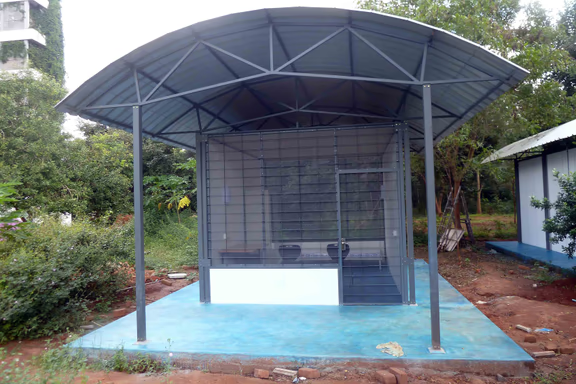La Maison des Jeunes
An interview with Louis CohenBy Alan
Keywords: La Maison des Jeunes, Citadines, Volunteers, Affordable housing, Newcomer housing and Newcomers

One of the 'Houses of the Young' at Citadines

Louis (left) with two volunteers, Mariano and Christoff
“It came about”, explains Louis, the inspiration behind the project, “because one day a volunteer was telling me there were many young people like himself who wanted to work in Auroville, and maybe even join the community, but who do not come because they cannot afford to stay. It set me thinking. The young volunteers who come here pay for their travel, they pay for their food and accommodation once they arrive, they work very hard, yet we seem to offer so little in return. I felt we had a responsibility to these people, to make it easier for them to contribute their energy and idealism to the building of Auroville. So I decided to do something about it by providing them with affordable accommodation.”
Louis decided that the best place to conduct the first experiment was on open ground close to Citadines. Citadines 3, the next apartment block planned for the area, is due to be built here but it may take six years to break ground on this project. “I also felt that the spirit behind this new settlement – which is that of the gift economy – was the same one that animates Citadines. So it was a very good match.”
As the site is temporary, Louis decided that the new settlement needed to be dismantled easily. In fact, the whole settlement can be taken down within one month and put somewhere else: almost everything is reusable, even the foundations.
La Maison des Jeunes consists of 12 small stand-alone rooms for 12 people. In addition, there is a collective laundry, kitchen and dining hall, a collective toilet and bathroom block and a covered space for drying clothes.
Clearly, a lot of thought has gone into the design. The individual rooms, which are 3 metres x 4 metres inside with a small outside terrace, are an interesting blend of functionality and aesthetics. The walls are prefabricated panels with insulating material inside, grills on two sides of the room provide cross-ventilation, there is a false ceiling in attractive pine, while the curved roof is made of steel.
“We will keep experimenting but already, as a temporary house, I think it is a success,” says Louis. “There is rain protection, good ventilation, heat insulation, and even aesthetically it is quite acceptable.” A nice touch is that the floor of each individual room is of a different colour, matching the different colours of the meditation rooms in the petals of Matrimandir. Each room will be named after one of these meditation rooms.
“We deliver everything finished, everything a volunteer needs,” Louis adds. “In each room there is a cupboard, bed, mattress, sheets, desk and two chairs. There is even a 24 hour Wi-Fi connection.
“The residents have to cook for themselves, but we provide the cooker, fridge, all the kitchen utensils and, in a separate room, a washing machine. And all the electrical connections are hi-tech fibre optic.” The residents simply have to pay Rs.1000 a month each to maintain the place, far less than they would have to pay in a guesthouse. “And even this is negotiable; we will find a way for them to stay if they have difficulty in paying because we need people like this.”
How are they selected?
“Basically you have to be between 18 and 30 years to live here,” says Louis, “and to be willing to put your energy into some work in the city centre. Of course, rules are made to be broken – it is the spirit behind which is important. Also, we want to mix Newcomers and volunteers, so four of these units will be for Newcomers. We hope that the Newcomers will take up responsibility for the organization of the place.”
Does Louis see this as a replicable model for temporary housing in Auroville? “Very much so. There is a potential space in the International Zone and I would like to suggest to the Housing Board that they let me do a similar project there, mainly for Newcomers. But we are also going to make a book, a kind of workshop manual, so that anybody can make these units. In any case, when we’re finished here, I want to continue with the fabrication of the units because many people are asking for them.”
What about the cost? Louis believes that, with design improvements and if the individual is willing to contribute their own labour, the cost of each room can be brought down to about one and a half lakhs for the raw materials. He estimates that the entire project, which he has funded himself, has cost around 36 lakh rupees without including furniture. Of course, while they did employ paid labour, volunteers, aided by some enthusiastic residents of Citadines, have done a lot of the work and this has saved money. Moreover, they have been able to plug into the existing infrastructure of Citadines, and Aurovilians like Carlos, Gegna and Jean Pougault have played a key role in constructing and managing this project.
However, provided you can link up with some available infrastructure, one a half lakhs for a simple but comfortable room is an extremely attractive price given today’s exorbitant construction rates.
Today, after 8 months, the construction stage is almost complete and the first volunteers and Newcomers have moved in. Louis is a happy man. “There was a very good spirit here during the construction, and the whole project has been done in the spirit of a gift economy. This, I believe, is how Auroville as a whole should function. I am an unashamed utopian in this utopia of Auroville!”